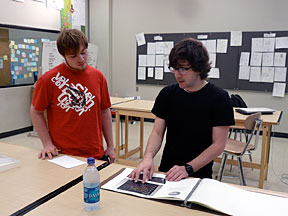Doug Barrett knows what many people are thinking when they hear the words "graphic designer."
 |
| Beau Bergeron (right) reviews the portfolio of graphic design student Jonathan Greene. Bergeron, a communications designer with IDEO, worked with Doug Barrett’s graphic design students for three days as the Department of Art & Art History Jemison Visiting Artist. |
What many people fail to grasp, he says, is that being a graphic designer means you have to know and understand businesses. You have to do business research to give yourself a map for success.
"People in general - students and clients in the business world - think graphic design is this very artistic and magical process, and in reality it's a very business-centric process," says Barrett, an assistant professor in graphic design and 20-year veteran in the graphic design business. "You have to find out the needs and audience of your client and identify their brand identity. There's definitely a creative aspect to it, but if you're not meeting your clients needs, it doesn't really matter how creative something is."
Barrett says the question many graphic artist students then have is, "How does graphic design or any kind of design work get done?" Barrett recently invited IDEO Communications Designer Beau Bergeron to speak to his students on that topic as his Department of Art & Art History Jemison Visiting Artist. Bergeron's lecture, "How to Get Everything You Want out of School, Job Hunting and Life," showed the students his own wild ride to score the job of his dreams and live life by his own rules.
A friendship dating back several years enabled Barrett to bring Bergeron from IDEO, a global design consultancy that aims to create impact through design. Barrett met and became friends with Bergeron in graphic art school at the University of Florida. After graduation, Barrett sought a position as an instructor and found a home at UAB. Bergeron chased his dream job with IDEO.
Barrett thought bringing in someone as young and experienced as the 25-year-old Bergeron would enable his students to learn how he crafted his own success at such an early age, and give them real-world insight into how one of the world's top experience-design companies achieves its success.
"Beau came in and spent three days with the students, walking them through his own history and how IDEO approaches its design thinking," Barrett says. "IDEO is known for the way they brainstorm ideas, and he took the students all the way through it."
Using IDEO's creative method of learn, look, ask and try, Bergeron had students brainstorm the idea of connecting a soda vending machine to cell phones and social networking.
Bergeron encouraged the students to come up with all ideas - "No idea is too crazy," he says before adding, "Do not play it safe today." The students worked, shouted and waved for 40 minutes, drawing out ideas on sticky notes that he posted on a window - a staple IDEO brainstorming method.
"The exercise is about building on other people's ideas," Barrett says. "It's not to talk about whether an idea will work or not; it's about getting any and all ideas out on the table first."
Students used their new IDEO skills to ideate, remix and create artwork for vinyl door graphics based on feedback questionnaires from the department faculty. Bergeron led the students through the formal process steps necessary to create smart, thoughtful work that answered the clients' needs.
Portfolio reviews and one-on-one sessions also gave students the opportunity to get professional feedback on how their own work might be perceived by someone - an area in which Barrett says Bergeron excels.
"The way Beau got his job was selling himself," Barrett says. "He created a five- to 10-minute video that talked about who he was as a person and what he likes to do as a designer. He basically stood up in front of this board of directors at IDEO and had this movie projected on his shirt and was taking off shirts as the video was being projected on him.
"That's the kind of thing these companies are looking for out there - that creativity and gutsiness. They want to find people who aren't afraid to look silly or go out and try things. That's the way they make their money."
Locking in on the creativity needed to bring out the best in someone's product isn't always easy, which is where the business side comes in to play.
Graphic designers have to know - inside and out - the company they are working for, their product and their needs. Barrett says there are many times, however, when a company will ask for help, but won't know what it is they want the graphic designers to do.
"That's where real data-driven information comes into play and helps you get to that creative end," Barrett says. "It helps for you to be able to go back to a meeting with your client and say, 'Okay, here's what we discovered about your product and here's what we discovered about your competition and your customers.' All of a sudden, it will oftentimes click with the client what it is they need."
Barrett says the three-day exercise for his students with Bergeron will pay dividends for his students as they map out their career goals.
"I think the three days of intense learning from someone who is young and successful and immersed in the field will be very beneficial," Barrett says. "This was a great way for students to see how to start building their own design practice."